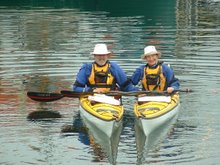We wanted to catch a relatively early ferry across to the Lofoten Islands, so we were in good time so that we could first drive around the southwest end of Langoya. Although it was alittle hazy looking south into the sun, the distant Lofoten mountains looked impressive as we drove through the farmlands surroundings the margins of Hadseloya.
The Melbu to Fiskebol ferry had quite a roll, even though the seas were calm. We decided that it could be a really interesting ride on a rough day! The ferry is currently the only way for vehicular traffic to reach the Lofotens. By this fall, a new road should be completed which will make it easier to get on and off the islands, and no doubt, will increase the traffic on Lofoten‘s narrow twisting roads.
At Fiskebol, we immediately turned off the main highway, and headed west along the north shore of Austvagoya (the eastern-most district of the Lofotens) through Sanden, Delp, Laukvika, Matmora, Eidet and Vestpollen.
After seeing such a mountainous vista of the Lofotens on the horizon as we approached, we were surprised to find this part of the island to be so flat. There were numerous, prosperous looking farms just west of Fiskebol. As we headed west, the farming diminished, and the number of hyttes increased.
The view heading into Vestpollen was spectacular as we approached the snow-capped mountains of the Lofoten ‘wall’. John took a ‘couple’ of pictures here!
We reconnected with the main highway, E10, and had lunch overlooking the fjord just east of Leknes in the bright sun. We drove past Svolvaer, but having heard so much about Henningsvaer, we couldn’t resist stopping for a quick look, and you guessed it, more pictures. We eventually carried on through Leknes, and through a tunnel that passes under one of the many inter-island channels. Most of the Lofoten islands are interconnected by elegant sweeping bridges. As we approached Leknes, we were amazed to be driving down the axis of a broad, extensively farmed, valley several kilometres wide. Again, Lofoten is usually remembered for its spectacular mountains that rise 750 to over 1000 m above sea level. No one ever mentions the farming, and the sheep.
As we drove, we could see that the large fog bank from the Norwegian Sea to the north was pushing its way into the valleys and fjords of Lofoten. In places, the fog flowed over and around the hills and fingered down the valleys, leaving the mountain tops in the brilliant sunshine above.
We made another quick stop at Sund, a small fishing village; the lighting was good.
Everywhere we looked, there was rack after rack (fish flakes) loaded with drying cod (stockfish). The Lofotens apparently supply 85% of the world’s market for stockfish, much of which goes to Italy. The cod which is caught during the winter season is dried in racks for 2-3 months before being stacked on pallets. The climate is surprisingly dry here so perfect for this process which has been practised since the early days of Viking exploration.
We arrived at A, the end of the twisting, cliff-hugging road down the length of the Lofotens. We were tired, particularly our eyes, because had seen so much marvellous scenery today. It was almost too much to take in. There was WOW scenery at every corner!
We managed enough rational thought and decision-making to pick a nice rorbua at Sakrisoy, just north of Reine. A ‘rorbua’ (ror = rowing a fishing boat; bu = to live or stay) is the name for accommodation used by fishermen during the 1800’s when they came from all over to fish the waters around the Lofotens. Today, many of the old rorbua have been rebuilt for tourist accommodation.
We had supper in Hamnoy. Sherrill had a ‘large’ plate of ‘large’ cod tongues (dedicated to Sue). John had a traditional Norwegian dinner called Boknafisk (reconstituted ‘klipfish’ (partially dried for only two weeks), boiled with potatoes, carrots, etc.). Dessert was another traditional dish … tapioca pudding with chocolate, ice cream and berry sauce. We both rolled home to bed in the blazing midnight sun.
Friday, June 8, 2007
Subscribe to:
Post Comments (Atom)

No comments:
Post a Comment